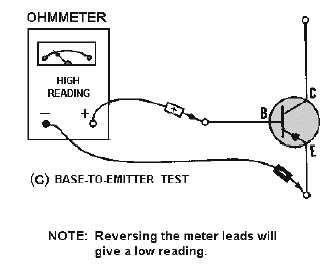2-36
Figure 2-19C.—Testing a transistor's leakage with an ohmmeter. BASE-TO-EMITTER TEST
Now consider the possible transistor problems that could exist if the indicated readings in figure 2-19
are not obtained. A list of these problems is provided in table 2-2.
Table 2-2.—Possible Transistor Problems from Ohmmeter Readings
RESISTANCE READINGS
PROBLEMS
FORWARD
REVERSE
The transistor is:
LOW (NOT SHORTED)
LOW (NOT SHORTED)
LEAKING
LOW (SHORTED)
LOW (SHORTED)
SHORTED
HIGH
HIGH
OPEN*
*Except collector-to-emitter test.
By now, you should recognize that the transistor used in figure 2-19 (view A, view B and view C) is
a PNP transistor. If you wish to test an NPN transistor for leakage, the procedure is identical to that used
for testing the PNP except the readings obtained are reversed.
When testing transistors (PNP or NPN), you should remember that the actual resistance values
depend on the ohmmeter scale and the battery voltage. Typical forward and reverse resistances are
insignificant. The best indicator for showing whether a transistor is good or bad is the ratio of forward-to-
reverse resistance. If the transistor you are testing shows a ratio of at least 30 to 1, it is probably good.
Many transistors show ratios of 100 to 1 or greater.
Q38. What safety precaution must be taken before replacing a transistor?
Q39. How is the collector lead identified on an oval-shaped transistor?
Q40. What are two transistor tests that can be done with an ohmmeter?
Q41. When you are testing the gain of an audio-frequency transistor with an ohmmeter, what is
indicated by a 10-to-1 resistance ratio?

